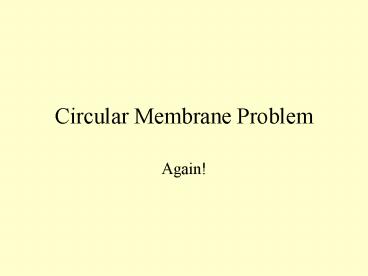Circular Membrane Problem PowerPoint PPT Presentation
1 / 26
Title: Circular Membrane Problem
1
Circular Membrane Problem
- Again!
2
The circular membrane has a radius of
a
3
Lets return to the study of the wave equation
with a circular boundary condition
Has separable solutions
where
.
4
Lets return to the study of the wave equation
with a circular boundary condition
Has separable solutions
where
.
5
Lets return to the study of the wave equation
with a circular boundary condition
Has separable solutions
where
.
6
Lets return to the study of the wave equation
with a circular boundary condition
Has separable solutions
where
.
7
Lets return to the study of the wave equation
with a circular boundary condition
Has separable solutions
where
.
8
Lets return to the study of the wave equation
with a circular boundary condition
Has separable solutions
where
.
Bessels Equation
9
Boundary conditions make this a Sturm-Liouville
problem on 0,a.
The BC at the (regular singular) point
is
finite.
10
The radial factor of the solution is a Bessel
function of the first kind
11
The radial factor of the solution is a Bessel
function of the first kind
Bessel functions are to cylindrical waves what
cosines/sines are to waves on a straight line.
12
The radial factor of the solution is a Bessel
function of the first kind
However, Bessel functions are NOT periodic and
the distance between zeros is NOT constant.
13
The only remaining BOUNDARY CONDITION of the
circular membrane problem is that
at
This implies that
.
Therefore
nth positive zero of
(And let .)
14
Therefore
Which is a solution of a SL problem with
eigenvalue
and weight function
.
(See lecture 11.)
15
Therefore we have the SS
And the GS
(See (13.1.1) of the notes.)
16
So we now have the GS of the circular membrane
problem.
What about ICs?
17
(No Transcript)
18
(No Transcript)
19
(No Transcript)
20
As an aside, here is a plot of
21
Plot of
REMEMBER
Unlike the sine and cosine functions
The roots of are not equally spaced.
22
Plot of
REMEMBER
Unlike the sine and cosine functions
The roots of are not equally spaced.
However, the procedure is still analogous to the
sine case of the 1D wave equation.
23
So, recall that we have
24
As shown in section 12, the Sturm-Liouville
theory gives us
25
(No Transcript)
26
Therefore
where

